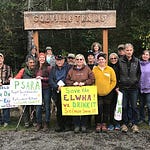A recent column in the Sequim Gazette raises serious questions about the role of local media—publishing glowing praise for a costly, controversial public project while refusing equal space to those who funded it and lived with its consequences. Journalism has lost its way, ceased serving the people, and begun protecting the powerful. Here’s the proof.
When a newspaper becomes a mouthpiece for the government rather than a watchdog for the people, democracy suffers. Unfortunately, that’s exactly what’s happening at the Sequim Gazette. Their recent “County Spotlight” column, authored by Clallam County Commissioner Mark Ozias, is more than just a soft-focus summary of a controversial project—it’s a prime example of how local media has abdicated its responsibility to the citizens it claims to serve.
Commissioner Ozias’ column touts the completion of the Towne Road realignment project, claiming, “Total cost to local taxpayers was less than $1.1 million.” That number is demonstrably false. According to the County Administrator’s own presentation to the Board of Commissioners, more than $1.3 million in local funds were spent—taken directly from the County Road Fund and Real Estate Excise Tax funds.
That figure doesn’t even touch the tens of millions more in state and federal tax dollars poured into the project, which Clallam County residents also helped fund.
The omission isn’t just misleading—it’s a betrayal of the public trust.
Tragedy ignored, criticism deflected
Commissioner Ozias paints the project’s impact as a minor inconvenience: a bit of road noise, some detours, maybe a traffic jam. What he doesn’t mention is the house fire that claimed a family’s home and pets while first responders were forced to detour five miles due to the road’s closure (a road that was never to close for even one day but was closed for two years). Even the local fire chief acknowledged that the detour contributed significantly to the outcome. These are not just “impacts”—they are life-altering consequences.
“You may have been inconvenienced by the road closure or construction noise and traffic.” — Commissioner Mark Ozias
Rather than engage meaningfully with critics, Commissioner Ozias waves them away as purveyors of “online vitriol.”
“Some have merely digested years’ worth of online vitriol alleging cost overruns and mismanagement related to this project and may be experiencing chronic indigestion.” — Commissioner Mark Ozias
But the public outcry wasn’t baseless anger—it was a demand for transparency and accountability. Commissioner Ozias was invited to a community rally at the Dungeness Schoolhouse in 2023 and to a People’s Forum event in April 2024 to answer questions. He declined both invitations. Instead, he met behind closed doors with the Jamestown S’Klallam Tribe on sovereign land, where the final details of the project—including a premium stormwater filtration system—were hashed out without public input.
This system, by the way, goes far beyond state requirements and is the only county road in the state with such a design. It’s also the only one whose ongoing maintenance and monitoring costs were quietly shifted to the taxpayers—another cost Commissioner Ozias forgot to mention.
The Tribe, the dike breach, and the price of political favor
In 2022, the Tribe deliberately breached a section of the Dungeness levee ahead of schedule, increasing flood risk to downstream communities, which nearly caused a mass casualty event. Commissioner Ozias acknowledged the emergency this caused but then praised the Tribe for “stepping up” and spending $1 million to remove the old levee.
“The Jamestown S’Klallam Tribe stepped up and spent more than $1 million to remove the old levy while our contractors were building the new one.”
What Commissioner Ozias also omits is that when the County proposed a $200,000 temporary fix to the breach, the Tribe rejected it—not because it wouldn’t work, but because, as an employee of the Tribe put it, “Chairman Allen is not in favor of this solution.” Instead, the Tribe insisted that the County place $15 million into a bond as a financial guarantee that a more expensive option would be pursued.
That’s quite a way to spin a costly blunder. It’s worth mentioning that the Jamestown S’Klallam Tribe contributed over 50% of Commissioner Ozias’ campaign funds in 2023. Praising your largest donor for creating and then helping to clean up a crisis doesn’t exactly inspire confidence, especially with the Dungeness Off-Channel Reservoir Project beginning.
Commissioner Ozias concludes his glowing report by inviting the public to “join me in celebrating this remarkable effort.”
Silencing the citizens
After reading Commissioner Ozias’ piece, I reached out to Sequim Gazette editor Kathy Cruz and asked to write an op-ed of similar length correcting the record. Her response? Since I “played no decision-making role in the Towne Road project,” a letter to the editor would be more appropriate and something she would consider.
We, the taxpayers, had no role in the decision-making, no voice in the planning, and now—according to the Sequim Gazette—we’re not even allowed equal access to the public square to discuss the consequences. The very people who paid for this project and suffered its consequences are denied a platform, while the elected official responsible for it is handed a megaphone.
But not everyone has been held to that standard.
When private citizens Craig Smith and Tony Corrado supported the creation of a “Water Steward” position—an entirely new government office—they were granted space in the Gazette to make their case.
I’m a Charter Review Commissioner, clearly meeting the “decision-making role” standard, but when I asked to submit an op-ed raising concerns about adding a Water Steward position that would grow bureaucracy in an already struggling economy, my email was ignored. Not only that, it was forwarded to the entire Charter Review Commission by the Sequim Gazette—an unusual and unexplained move.
Where is the consistency? Bertha Cooper regularly publishes political commentary in the Sequim Gazette without holding any official role. The League of Women Voters wrote about the Charter Review Commission without having any authority over it. So why is my voice, and the voices of others like me, being silenced?
Curating the narrative, not reporting the news
Local newspapers are supposed to be the immune system of democracy, catching infections of corruption and shining light into dark corners. But when the Sequim Gazette chooses to act as a press office for elected officials—especially those whose campaigns are financed by powerful interests—it becomes part of the problem.
What’s worse, Sound Publishing, which owns both the Sequim Gazette and the Peninsula Daily News, isn’t just asking for subscriptions—they’re asking for donations. They claim they’re struggling to survive. But media outlets don’t die because people stop valuing journalism—they die when they stop doing journalism.
When truth is filtered, facts are curated, and criticism is silenced, it’s not journalism. It’s propaganda.
The Sequim Gazette had a choice: act as a guardian of the people or a guard dog for the powerful. They chose the latter. And until the people reclaim their voice, there’s no reason for elected officials to descend from their ivory towers. Why would they? They already control the message.
Last Equitable Wednesday, readers were asked which group is most overlooked in public proclamations. Of 173 votes:
48% said crime victims
44% said veterans
7% said low income/homeless individuals
1% said racial/ethnic minorities
1% said 2SLGBTQIA+
The following article was written by Commissioner Mark Ozias and published in the Sequim Gazette.
County team, grants bring benefit to community through Towne Road project
By Mark Ozias Clallam County Commissioner, District 1 • June 25, 2025, Sequim Gazette
The spotlight is always on counties when we undertake a big public works project: building a roundabout at a busy intersection, repairing sewer mains along a crowded street, or improving habitat in a critical area. A momentous mile marker has just been achieved in one such public work, namely the 15-year-long project to expand the Lower Dungeness floodplain and to rebuild Towne Road.
All grants have been closed out and we can finally review the project in its totality.
If you lived, drove or recreated in the Dungeness area over the past few years then you certainly experienced some impact from this project. You may have been inconvenienced by the road closure or construction noise and traffic. Perhaps you are now birdwatching along the restored floodplain habitat as it attracts new wildlife, or utilizing the dedicated roadside trail. Some have merely digested years’ worth of online vitriol alleging cost overruns and mismanagement related to this project and may be experiencing chronic indigestion.
Around 2008, momentum began to build around a concept to expand and restore a significant portion of the Dungeness River’s floodplain by building a new, modern and safe levee away from the river. As it took shape the project aimed to improve habitat, including critical habitat for endangered salmon species, while mitigating flooding concerns.
This project was funded by nine separate state grants totaling more than $22 million, mostly through the “Floodplains by Design” program and the Washington Recreation and Conservation Office. This complex patchwork of funding covered all expenses related to planning, design, land acquisition, floodplain restoration and construction.
Significant changes occurred as the project progressed, including the Army Corps of Engineers unexpectedly pulling out as project manager in 2016, the onset of the COVID-19 pandemic and the potential for the adjacent and complimentary “River’s Edge” levee setback project made possible by the Jamestown S’Klallam Tribe and the North Olympic Land Trust.
By the spring of 2022 the “River’s Edge” upstream project and the county’s downstream project construction timelines were no longer in alignment which resulted in a lack of levee connectivity between the “upriver” and “downriver” projects, creating a potential for flood risk. An emergency was declared and we began to work on a plan to ensure residents’ safety.
What transpired next was nothing short of amazing. The county worked closely with our contractor to complete in three months the work originally intended to take place throughout 2023.
The Jamestown S’Klallam Tribe stepped up and spent more than $1 million to remove the old levy while our contractors were building the new one.
The levees were connected to provide necessary flood protection. And, importantly, the historic Towne Road and all of its attendant contaminated soil was removed from the middle of this brand new floodplain. All of this work was completed just ahead of a major flooding event that tested the integrity of the new system, which passed with flying colors.
Next came consideration of how to move forward with re-connecting Towne Road. After processing a tremendous amount of public input, the director of community development recommended a road design that would include a pedestrian trail and our public works team got to work on designing this unique section of road.
We worked through a maze of state and federal permitting steps, including incorporating new stormwater runoff technology to protect the sensitive areas. All work was completed and the new Towne Road opened to the public on October 8, 2024.
Way back in the early 2000’s, the county estimated the cost of simply re-doing Towne Road in place at $1.2 million in local dollars. Thanks to great support from state funders and a dedicated and creative team at the county, residents ended up with a restored floodplain habitat, improved protection against flooding, a section of county road with the most modern stormwater technology, a guardrail for safety and an elevated, dedicated pedestrian trail.
Total cost to local taxpayers was less than $1.1 million. Please join me in celebrating this remarkable effort.
















